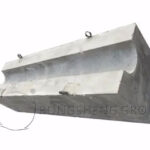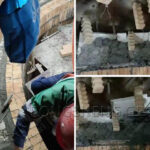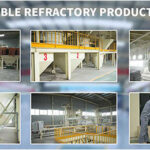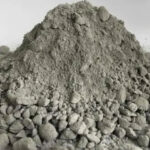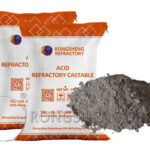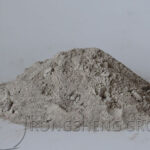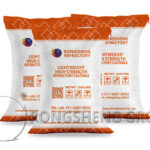We are a professional manufacturer of calcined bauxite aggregate, offering a comprehensive range of products including lumps, aggregates, and fine powders. We process and sell a wide range of aggregates and fine powders (containing 60-90% aluminum) and can also customize them to meet customer needs. Particle sizes include: 0-1mm; 1-3mm; 3-5mm; 5-8mm; 8-15mm; and 80-325 mesh. Our aggregate products are high-quality and competitively priced. Contact us for free samples and a quote.
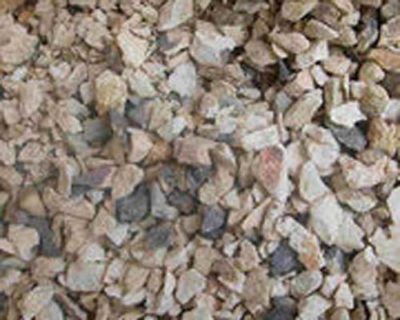
Bauxite Calcination Process
The bauxite calcination process follows: raw materials entering the factory → crushing → screening → calcination → crushing → finished product delivery.
Equipment for Calcining Bauxite
In the process of producing calcined bauxite aggregate clinker, the calcination of bauxite has a great influence on the quality of the clinker. Therefore, it is very important to choose a kiln for calcining bauxite. The main equipment for calcining bauxite includes downdraft kiln, rotary kiln, tunnel kiln, etc.
(1) Downdraft kiln is an intermittent kiln. Its name is derived from the flow of flame. The flames generated by combustion all rise from the fire nozzle of the combustion chamber to the top of the kiln. Since the kiln top is sealed, the flames cannot continue to rise. In the absence of an air outlet at the top of the kiln, they are pulled downward by the suction force of the chimney. After passing through the gaps in the sagger columns, they enter the branch flue and the main flue from the fire-absorbing hole at the bottom of the kiln and are finally discharged from the chimney. Because hot gases are light in weight and always float on the surface, people are accustomed to calling the flames flowing from bottom to top “shun”. The flames flowing from top to bottom are called “reverse”. This is the origin of the name “downdraft kiln”.
The advantages of the downdraft kiln are that the kiln volume can be large or small, which is flexible in production and can produce high-quality products. The construction investment cost is low and the metal material consumption is low. The disadvantages are that it is intermittent operation and the exhaust gas temperature is very high when it leaves the kiln, so the fuel consumption per unit product is high. The production scale is small and the working conditions are poor. The mechanization level is low, the operation and control are difficult, and the production efficiency is low. The environmental performance is poor. Generally, the thermal efficiency of the downdraft kiln is only 6.48%, while the coal consumption per ton of finished product is as high as 1.456 tons.
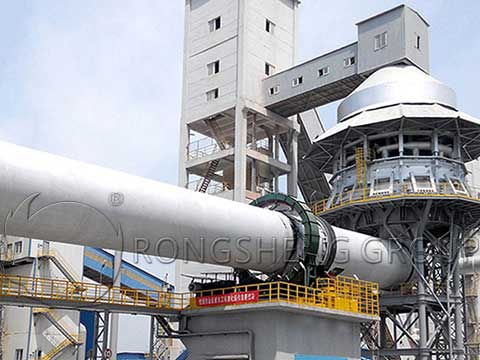
(2) The rotary kiln refers to a rotary calcining kiln, which originated in cement production. Rotary kiln equipment is now widely used in many production industries such as building materials, metallurgy, chemical industry, and environmental protection to perform mechanical, physical or chemical treatment on solid materials. Most rotary kilns for calcining bauxite have changed from heavy oil as fuel to coal powder as fuel. The coal consumption for calcining 1 ton of high-bauxite is 200-250kg. The characteristics of rotary kilns are: simple structure, few vulnerable parts, easy to control the production process and high operating rate. It is easy to mass produce and easy to realize automatic control, and the product quality is stable.
(3) Tunnel kilns are modern continuous firing thermal equipment, widely used in the roasting production of ceramic products, and also used in metallurgical industries such as abrasives. Tunnel kilns are mainly used for the firing of products. The refractory industry can be divided into three types according to the different operating temperatures. Low-temperature tunnel kilns are mainly used for roasting skateboard bricks, etc., with a firing temperature of about 1000℃. Medium-temperature tunnel kilns are mainly used for firing ordinary alkaline bricks, clay bricks, high-alumina bricks, silica bricks, etc., with a firing temperature of 1300℃-1650℃. High-temperature tunnel kilns are mainly used for firing mid-range magnesia bricks, high-purity magnesia bricks, magnesia-alumina and corundum products, with a firing temperature greater than 1700℃, generally between 1800℃-1900℃. The labor intensity is high, the production efficiency is low, the heat consumption is high, and it is difficult to realize automatic control.
At present, for calcined bauxite aggregate, large-scale bauxite calcining production systems at home and abroad all use rotary kiln equipment and technology.
Advantages and Disadvantages of Ceramic Aggregates and High-Alumina Aggregates
As two important refractory and construction materials, ceramic aggregates and high-alumina aggregates each possess unique advantages and disadvantages. Below is a detailed comparison of their advantages and disadvantages:
Ceramic Aggregate
Advantages
- Reduced Density: Compared to traditional concrete aggregates, ceramic fine aggregate has a lower density, effectively reducing the overall density of concrete, thereby reducing the load on the building itself.
- Increased Strength and Durability: Ceramic fine aggregate has higher strength and hardness, effectively improving the compressive strength and durability of concrete, making it stronger and more durable.
- Reduced Environmental Pollution: Traditional concrete production produces large amounts of carbon dioxide and other pollutants, while ceramic fine aggregate concrete can effectively reduce environmental pollution and improve production efficiency.
Disadvantages
- Higher Cost: Because the production cost of ceramic fine aggregate is higher than that of traditional aggregates, the cost of ceramic fine aggregate concrete is also higher, increasing the overall cost of concrete structure construction.
- Difficult Construction: The construction of ceramic fine aggregate concrete is relatively difficult, requiring high technical requirements and construction experience, as well as special construction techniques and equipment.
- Poor Seismic Resistance: Due to its lower density, ceramic fine aggregate concrete has inferior seismic performance compared to traditional concrete.
High-Alumina Aggregate
Advantages
- High Strength and Hardness: High-alumina aggregates offer high strength and hardness, capable of withstanding high temperatures and mechanical stress, ensuring a stable and safe production process.
- High-Temperature Resistance: High-alumina aggregates, calcined bauxite aggregates are primarily made from bauxite calcined at high temperatures. They contain a high proportion of aluminum oxide, resulting in excellent high-temperature resistance.
- Chemical Stability: High-alumina aggregates exhibit excellent chemical stability at high temperatures and are resistant to reactions with acids and alkalis, maintaining excellent stability in aggressive media.
- Wide Applications: High-alumina aggregates are widely used in ceramics, metallurgy, and the chemical industry. They are an indispensable raw material for applications such as refractory bricks, castables, and gunning mixes.
- Thermal Insulation: High-bauxite aggregates are rich in alumina and have low thermal conductivity. They reduce indoor heat loss in winter and block external heat conduction in summer, providing greater building comfort and contributing to energy conservation and environmental protection.
- Durability: Due to its high content of alumina, high-alumina aggregates are impervious to deliquescence, moisture, and water erosion, and are also resistant to acid and alkali corrosion. This extends the lifespan of buildings and reduces maintenance costs.
Disadvantages
- High Cost. Due to the complex production process and high raw material costs, high-alumina aggregates command a relatively high market price.
- High production equipment and processes are required. The production of high-alumina aggregates requires advanced equipment and processes to ensure product quality and performance.
In summary, ceramic aggregates and high-alumina aggregates each have their own unique advantages and applications. Choosing which aggregate to use requires careful consideration based on the specific project requirements and budget.

